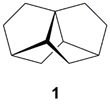Trinorbornane: Expanding the Chemical Space
One of the challenges of synthetic organic chemistry is structural diversity, in particular, at the level of small molecular building blocks.[1] New compounds and compound classes in the size range of small molecules (less than 500 g/mol) are of interest since they may display unforeseen properties and lead to new structural motifs.[2] The computer-assisted enumeration of the chemical space addresses this challenge by generating all possible molecules for a give number of atoms (excluding hydrogen) under consideration of specific rules.[3] One particular example found in the chemical universe database (GDB-11) is the tetracyclic hydrocarbon 1. This esthetically pleasing, C2-symmetrical, chiral molecule is comprised of three partially superposed norbornyl units. It is surprising that this unstrained molecule has not yet been synthesized in over 100 years of norbornane chemistry.[4] The goal of this project is to synthesize and study the properties of hydrocarbon 1. The total synthesis of this compound as well as the crystal structure of the dimer will be presented.

[1] L. C. Blum, J.‐L. Reymond, J. Am. Chem. Soc. 2009, 131, 8732–8733.
[2] T. Fink, J.‐L. Reymond, J. Chem. Inf. Model. 2007, 47, 342–353.
[3] L. Ruddigkeit, R. van Deursen, L. C. Blum, Jean-Louis Reymond, J. Chem. Inf. Model. 2012, 52, 2864-2875
[4] J.-L. Reymond, L. C Blum, R. van Deursen, Chimia 2011, 65, 863-867.